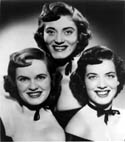
The McDonnell Sisters
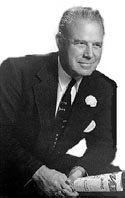
Horace Heidt
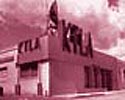
KTLA Studios
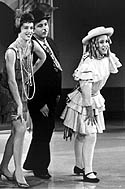
The Red Skelton Show
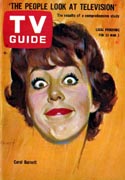
The Carol Burnett Show
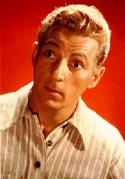
Danny Kaye
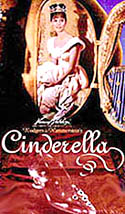
Cinderella
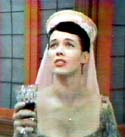
"I wish I were a sweeter girl..."
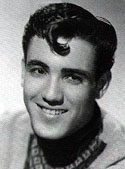
Jimmie Rodgers
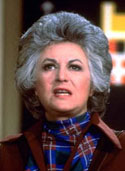
"...and then there's Maude!"
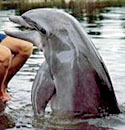
"They call him Flipper, Flipper..."
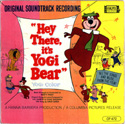
Hey There! It's Yogi Bear!

Cuter than the average bear!
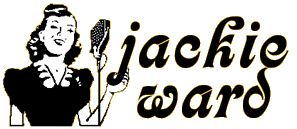
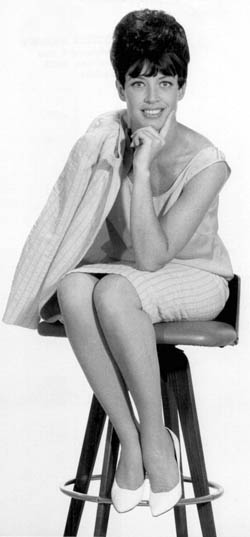 Fans of The Partridge Family know Jackie Ward as
the lone female voice, behind the scenes with the quartet of Studio Singers.
What many fans may not know, is just how extensive her on-screen career
is as well.† Reading Jackie Wardís resume, whether for TV, Movies
or Records, is like reading the Hollywood phone book. Danny Kaye. Carol
Burnett. Red Skelton. Rodgers & Hammerstein. Pat Boone. Frank Sinatra.
Barbra Streisand. The Carpenters. Sonny & Cher. Mama Cass. Shaun Cassidy.
Ray Conniff. Percy Faith. Anita Kerr. Joan Baez. The list goes on and on
and on. In addition to singing, she was often contracted to find the best
voices around for projects she was hired to assemble. Jackie was gracious
enough to sit down and reminisce about her career with Scott Awley and
cmongethappy.com from August through October, 2000. So sit back as we take
you on another spin around San Pueblo...
Fans of The Partridge Family know Jackie Ward as
the lone female voice, behind the scenes with the quartet of Studio Singers.
What many fans may not know, is just how extensive her on-screen career
is as well.† Reading Jackie Wardís resume, whether for TV, Movies
or Records, is like reading the Hollywood phone book. Danny Kaye. Carol
Burnett. Red Skelton. Rodgers & Hammerstein. Pat Boone. Frank Sinatra.
Barbra Streisand. The Carpenters. Sonny & Cher. Mama Cass. Shaun Cassidy.
Ray Conniff. Percy Faith. Anita Kerr. Joan Baez. The list goes on and on
and on. In addition to singing, she was often contracted to find the best
voices around for projects she was hired to assemble. Jackie was gracious
enough to sit down and reminisce about her career with Scott Awley and
cmongethappy.com from August through October, 2000. So sit back as we take
you on another spin around San Pueblo...
Get Happy: How did you become interested in music?
Jackie Ward:† Well, letís see. I came from a musical family. The first public performance I did was with my sisters in church. I was eight years old, and they were older. I had to stand on the piano bench in order to get up to their level. I sang the alto parts.
GH: Where were you raised?
JW: I was actually born in Hawaii and my father was in the Navy. I went from there to Nebraska, which is where my parentsí families are from. I grew up primarily in a small town in Nebraska.†
GH: How did your trek west start?
JW: My sisters and I sang in a trio, called The McDonnell Sisters. We entered a nationwide radio talent contest that a man named Horace Heidt ran. We auditioned, and then had to travel to Yangton, South Dakota with the other contestants. Thatís where the show was broadcast from. We won the contest! My parents thought, "Gosh, if they could do that, then we really should give them a chance to see what they can do in Hollywood." So, they up and moved us. I finished my last year of high school in California, because thatís when we moved.
GH: Did you start auditioning right away?
JW: Oh, sure! While I was a senior, we auditioned for KTLA, and they hired us for a television show called Bandstand Revue. We did that for about 4 years.
GH: What kind of music did you sing for the show?
JW: Bandstand Revue was like Your Hit Parade, which were songs of the day. So we sang all the songs that were popular then. This was around 1954.
GH: Hollywood is such a "closed door" type of town. Did working on KTLA help you get started?
JW: Well, actually ≠ not at all! After a while, my sisters decided that they didnít want to be in the business for various reasons, such as marriage, etc. Although I was married at the time too, I decided that I liked it enough to stick it out. So, I started doing demos for songwriters.
GH: Did you want to be an actress or a singer?
JW: Itís a funny story ≠ I think youíll appreciate this: When I was singing with my sisters, some star came on that was doing a number, and all of a sudden this background group showed up. And they were just like the musicians that played in the orchestra. The star was passing out music, and I am realizing that these singers have never met the star, nor have they seen this music before. That just blew me away. Here were singers that could do something that I couldnít do. I knew I could sing anything. Any style, or whatever because I had the voice. But I didnít know how to read music. It bugged me -- that I couldnít do what they could do, so I went to City College and learned music.
GH: Since you had been singing with your sisters, was it easier for you to pick out the harmonies?
JW: Oh, sure. My ears were so good. But it was just a matter of understanding what I was singing, and putting a name to it. Learning what the key signatures were, and how it all worked. It was all fairly simple. I was also married to a music copyist at the time, so I would practice by taking a score he was working on and take the different sections, such as the trumpet section, or the violin section, and practice sight reading what they had written, along with the rhythm. By doing that, I had a good head start. But while I was learning, I was also recording demos for songwriters, because thatís just the melody, which is a piece of cake.
GH: Songwriters needed demos recorded?
JW: Thatís the way they used to do it. Singers that worked for recording studios would be pitched all these songs by the writers. It was a different world then. That was the main way it was done. Songwriters sent the demos to the producers that were working with the artists. Producers would listen to all these demos and bring the ones to the artists that they felt worked best. Then the artists would pick and choose.
GH: How did that start for you? Did you have an agent, or answer audition ads in the paper?
JW: No, I never did any of that. I met a lot of people in the business while I was still doing the show. Itís just word of mouth ≠ somebody recommended me for something. Thatís basically how it happened. Even today, in the world of studio singers, itís still that way. An agent canít really get you a job. Itís not even so much who you know, as it is how capable you are, and that word gets around. Your reputation gets around.
GH: How did you get your start in front of the cameras?
JW: Alan Copeland was auditioning a whole bunch of singers for The Red Skelton Show.† I went in and auditioned. They were looking for three girls and four guys. Alan liked what I did and put me in the group. We were the set singers, and I did that every week. During this time, The Carol Burnett Show was going on, and I did that on several occasions, and I did The Danny Kaye Show as well. This was in the early to mid 60s.
GH: Did these types of TV gigs pay well?
JW: No, not at all.† Donít get me wrong ≠ I was thrilled to have the job and it was nice, but the better paying jobs ≠ for the time you put in -- were the record dates and commercials. So, I started picking up more and more of those. After a while, I found it was hard to continue doing the television show because it was interfering with the record dates, which paid more.
GH: How long would a record date take?
JW: It was usually a three-hour call. You would get paid either per hour, or per record side, with a minimal call. You could book three record dates easily in a day. So, you could make good money. Much better than a television show, because they have you all day for the one flat rate.†
GH: Tom Bahler mentioned that he used to hate getting a movie call, because it was an all-day affair. Did you have the same experience?
JW: Absolutely! If you got a movie call, that was an 8-hour call. Your day was gone. If you were lucky and they didnít go into overtime, you might be able to do a record job in the evening, but you couldnít always count on it. Youíre in big trouble if you went into overtime and you had also booked another gig!
GH: You were also in Rodgers and Hammersteinsí Cinderella, with Lesley Ann Warren. How did that come about?
JW: That was while I was doing the Skelton show. Everything just coincided because it was all right there in the same studio at CBS. I was the town prostitute in that.
GH: You were the prostitute? I thought you were a prospective princess for the prince?
JW: No, I think I was the town prostitute.
GH: Wow ≠ thatís quite a fall! From princess to prostitute!
JW: (Laughs) I know youíve talked to Tom and Ron, so you know that we worked with just about every star in Hollywood back then. Some were interesting, some not.
GH: Did you record with the stars or separately?
JW: Well, back then everybody recorded live. You recorded with the orchestra and the soloist was in a booth. We may have been in a booth as well but we could all see each other, and the conductor. It wasnít a separate room, just a small booth with a glass window so you could isolate the sound a bit.
GH: Who were you recording with at this time?
JW: I did a lot of stuff with Pat Boone, Jimmie Rodgers, Frank Sinatra, Nat King Cole, and I did one of the very last recordings that Bing Crosby did. That was a thrill, because I knew he wasnít going to be doing too many more.†
GH: Did you record any television themes?
JW: Oh, sure! I did so many sometimes itís hard to remember them all. I did the main titles to Flipper, Batman, and later on I did Love American Style and Maude. With Love American Style we were all there ≠ Tom, John, Ron and myself. Maude was just three girls and Donny Hathaway. I think Ron was with me on Batman and Flipper.
GH: You went from a prostitute in Cinderella to a little brown bear in Hanna-Barberaís animated motion picture, Hey There! Itís Yogi Bear! How did that come about?
JW: Hoyt Curtin was the composer for all of Hanna-Barberaís shows. He knew of me because my husband (at the time) copied music for Hoyt. He knew I had done a lot of things, and asked to hear me sing. When he did, he felt I was perfect to be the singing voice for Cindy Bear.†
GH: Why didnít you record the speaking voice as well?
JW: At that time Hanna-Barbera had a very tight handful of actors doing their voices. They had it all locked up. The only reason why I did the singing is because Hoyt insisted on it.†